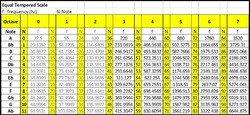In this Lesson you will learn about:
- How to create sounds using Binary code
- Share your music with other students
- Evaluate and improve your music
|
Lesson Overview
Lesson Starter:
Complete the MCQs In this lesson you will apply Binary code to create and store sound. Use the Tescos Value Beat Box program to experiment and create a little musical ditty. Using Python you will code a simple 'Theme Tune' using a sound machine sound machine. Click on the picture to see the MIDI value for each note.
|
Resources
|

